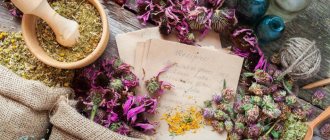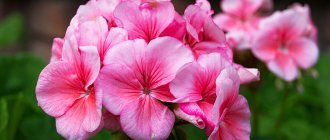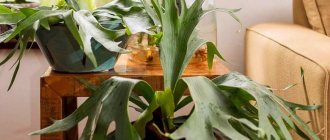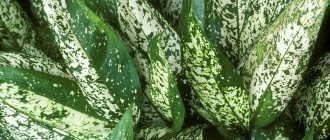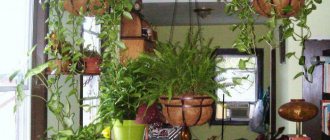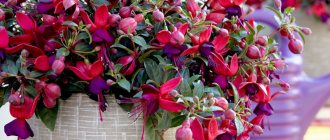» Signs » Is it possible to keep a monstera in the house - the magical properties of the plant
0
175
Article rating
Monstera in the house is a real exotic corner for relaxation and restoration. There are many signs and superstitions associated with it - positive and negative. Fortunately, the beneficial properties of vines are confirmed by experience and science, while the negative ones most often remain at the level of speculation.
What does it symbolize
In the East, this flower symbolizes longevity, good luck and good health. Along with anthurium and dieffenbachia, monstera is one of the most popular representatives of the araceae family.
A powerful vine with large leathery leaves with spectacular slits. At home, it grows up to 2-4 m and lives up to 15-20 years.
Its name translates as “bizarre” and “amazing”, and not “monstrous”, as is sometimes mistakenly believed.
People are often afraid of the impressive size of the plant, which is what most negative superstitions are associated with. However, Eastern sages consider it a protector from many misfortunes - physical, chemical and energy.
How can it be dangerous?
Negative associations with the monstera were due to its frightening appearance, reminiscent of a predator or monster, its name, which sounds like the word “monster,” and the fact that it grew on the skeletons of deceased people, allegedly causing their death. Contrary to false fears and prejudices, this representative of the green kingdom is not at all dangerous and poisonous; it can be safely kept at home.
The only danger is the small needle-like shoots (raphidas) on the leaves of the plant - they are poisonous , and therefore can cause irritation, burning and allergies in anyone who touches them or eats them. Because of this, the flower must be placed in a place where pets and small children cannot reach it. Otherwise, the monstera is no more dangerous than others, and in Asia its fruits are even eaten.
Can I keep it at home?
Monstera has acquired many superstitions, but most of them are false. In fact, it is perfect for keeping at home and brings nothing but benefits. Caring for it is not particularly difficult - it grows and reproduces well, although it does not bloom.
However, there is one unpleasant nuance - the poisonous juice in the leaves (they cannot be chewed or ingested). In houses where small children live, it is really risky to keep a vine, and as for pets, they intuitively avoid such plants.
A spectacular indoor flower, similar to a palm tree, looks decorative and exotic. It will decorate any room, as long as it is spacious. In addition, Monstera is well suited for keeping in an office, school, library and other public institutions. It can transform a dull hall, hall or corridor - the main thing is that there are no drafts there.
What does a monstera plant look like: photo
The name “monstera” in translation means “amazing” or “bizarre”. All three names can be easily explained by the appearance of the plant.
- The huge leathery leaves of this vine can reach 45 cm, and the slits and holes in them add even more mystery to the image of the monstera and give it a frightening appearance.
- With proper care, the length of the monstera reaches several meters, so when starting a monstera, try to provide the plant with reliable support.
- It has a developed system of aerial roots, with the help of which it climbs. It is not recommended to remove roots growing from the nodes of the main stem. You can direct them to the plant's pot or make separate bags of soil for each root. If there is a lack of soil, it will not climb.
- Monstera blooms annually, the flowers resemble a cob.
Important: With insufficient care, if you cannot provide the plant with comfortable climatic conditions, you may not see flowers.
- Monstera is a natural barometer. In cloudy weather, before rain, its leathery leaves become covered with moisture. The hydathoda organs located on the lateral veins are responsible for the secretion of this actually sticky juice. It is they who, when humidity is high, release liquid that flows from the wide leaves, as if the plant is “crying.”
Beneficial features
A large indoor plant with large leaves releases a lot of oxygen, which people need for health and vital functions. It is more joyful to live in such a room, it is easier to remain calm and focused, to work fruitfully and to recover quickly.
Monstera helps maintain normal humidity and well cleans the air in the house from harmful impurities (for example, formaldehyde), suppresses the development of viruses and bacteria. As a result, people feel better and get sick much less often.
The leaves of the vine attract dust and soot - the particles settle on them and do not enter the respiratory tract of people. In addition, it eliminates unpleasant odors.
The flower also absorbs magnetic waves emanating from technical devices.
Where should Monstera be located in the house?
Like any plant, monstera breathes around the clock. However, when choosing a place in the house for it, it is important to take into account one feature of this vine.
During daylight hours, it absorbs carbon dioxide and releases oxygen. At night, the reverse process occurs - the plant releases carbon dioxide. This is explained by the process of photosynthesis during daylight hours.
That is why it is not recommended to place a monstera pot in the bedroom or children's room.
Important: Please note that monstera still releases more oxygen during the day than carbon dioxide at night, so you should not fear for your health. This beautiful plant will decorate your home.
It is worth mentioning that Monstera absorbs electromagnetic waves, so its ideal placement is near electrical appliances (refrigerator, TV, computer).
Keep in mind that monstera is a fairly large plant. If it is not tied to a support and does not send roots into the pot, it can occupy a large area. In addition, it does not like direct sunlight, so it is better to choose a place where there is partial shade or diffused light.
Flower magic
- The plant neutralizes negative energy and prevents scandals, quarrels and hidden irritation from flaring up.
- Conflicts quickly fade away, but more often they don’t even get to the point - when you’re around him, you can’t remember evil or harbor grievances, and you’re simply too lazy to get angry and indignant.
- People become more determined, persistent, and purposeful. It is easier for them to find a purpose and follow their own path, regardless of the opinions of others.
- Monstera successfully fights the energy of chaos and promotes ideal order - in the home, in life and in the head. After spending a couple of hours next to her, a person gets rid of toxic thoughts and begins to think clearly, clearly and effectively. Strangely, there is no trash in the apartment, and most things usually fall into place.
- The flower helps cope with panic and restores mental balance. Spend 20 minutes on care - you will definitely relax and realize that everything is not so bad.
- In a house where there is this plant, people quickly return to normal after fatigue, stress, and tension. A magical green oasis calms you down and gives you strength: an hour of relaxation under its shade is enough to make you want new achievements.
- The unique energy of the vine promotes digestion, good metabolism and weight normalization. By constantly communicating with her, you will not overeat and will begin to prefer light, healthy food.
- In the East, they believe in the monstera’s ability to heal seriously ill people and drive away illnesses from their homes. If you place a flowerpot at the entrance to a patient’s room, he will quickly recover, and in the case of a viral or infectious disease, he will not infect anyone.
- The flower attracts good luck and prosperity, stabilizes finances, creates a feeling of security and confidence in the future.
How to avoid the consequences predicted in signs.
Yes, indeed, on the Internet you can find various reviews confirming the fact of the negative impact of philodendron on human life. Most likely, this is a banal coincidence, since it is human nature to look for the source of failure in anything but in oneself.
Important! Not a single sign or superstition associated with indoor plants, including monstera, has scientific evidence.
To avoid the consequences predicted in the signs, it is enough to adhere to certain rules.
Advice! If there are animals or small children in the house, it is better to place the pot with philodendron in a place inaccessible to them to eliminate the possibility of them eating the leaves of the vine.
Philodendron leaf sap and microscopic needles can cause skin irritation and damage to the integrity of mucous membranes.
For particularly impressionable individuals and people with a wild imagination, it is not advisable to place a large plant near a place of sleep and rest. The liana will be a wonderful decoration for the kitchen or hallway.
The most important thing is not to try to assign human properties to the plant and identify the plant with an energy vampire.
Signs and superstitions
Monstera is often called a “crybaby” or a barometer. Before rain, air humidity rises and droplets of juice appear on the leaves of the vine - in the tropics this serves as a reliable sign of imminent precipitation.
Sometimes it is called a “vampire”, citing its ability to take energy: first the plant collects all the negativity, and then gets to the positive vibrations. However, it does not “drink”, but balances: it removes excess, normalizes, and brings it to an optimal state.
According to popular superstition, the monstera drives suitors away from girls and, as a result, its owner risks being left alone. There is no justification for this sign, but based on logic, it can be assumed that men with negative energy and dishonest intentions dare. A brave, sincere and loving person is unlikely to change plans because of a plant.
Its gloomy image was created by legends of travelers who found human skeletons in its roots. From the outside it seemed as if the monster had strangled the unfortunate man. However, the solution turned out to be simple: people in the jungle died from various causes (disease, thirst, wild animals, poisoned arrows, etc.), and the vine simply wrapped itself around them with stems and aerial roots.
Is monstera harmful or poisonous to human health: impact on humans
Contrary to popular belief about the bad effects of monstera on health, it has been proven that it is absolutely safe even for people who suffer from allergies.
The myth about the poisonousness of the plant is also slightly exaggerated. Indeed, there are needle-like formations in the leaf tissues. If the juice gets on the mucous membrane, a burning sensation or even poisoning may occur. There are a number of symptoms to determine it:
- Numbness of the mouth
- Throat irritation
- Swelling of the mouth and throat
- Soreness
- Loss of voice
- Dysphagia
It is worth noting that such a reaction is only possible with close contact with the leaves, for example, if you rub the leaf and then rub your eyes or chew it.
Based on the above, we can conclude that the monstera can cause real harm either to pets who like to snack on flowers, or to inquisitive young children without supervision.
Interesting fact: The peoples of Southeast Asia believe in the medicinal power of the plant. Sometimes it is grown precisely in case of illness. Monstera is placed at the patient’s bedside, and sometimes they are even given a leaf to chew.
Feng Shui
Feng Shui masters recommend keeping this flower in your home or office to balance the energies of Yin and Yang.
They say that next to such a plant it is easier to come to an agreement, reach a compromise and a mutually beneficial solution.
It should not be placed in the nursery and bedroom, but it can be placed in all other rooms.
- In the hallway, the liana will become a real protector - it will eliminate the negativity that penetrates through the front door, ward off thieves, ill-wishers and simply unpleasant people. If you have accumulated worries and negative emotions during the day, she will not let you take it all home.
- If you keep a flower in the living room, mutual understanding and well-being of family members will improve. It will help you recover after a hard day, stress or illness.
- in the kitchen - balances the fire element, neutralizes vibrations from appliances, soot and bad odors. Normalizes digestion and metabolism, encourages moderation in food and a healthy lifestyle.
- In the office - promotes clear thinking, perseverance, concentration, creativity. A person works more efficiently and gets tired less. In addition, the energy of the liana activates cash flows and opens up new opportunities for earning money.
- In the office - eliminates quarrels and misunderstandings in the team, humidifies and ozonates the air, neutralizes magnetic radiation from computers and office equipment, and prevents overvoltage.
Remember: only a healthy plant has beneficial properties, which is why regular care for it is so important.
Benefits and harms
The table shows the positive and negative properties of monstera, which botanists talk about:
| Pros of the plant | Negative aspects of growing |
| Enrichment of the room with oxygen | Increased likelihood of nightmares occurring when a flower is placed at the head of the bed |
| Precipitation Prediction | Risk of mild poisoning due to the poison contained in the leaves |
| Air humidification | Increased risk of intoxication in the body of a child or pet |
| Destruction of pathogenic microorganisms | Uncontrolled indoor growth |
| Strengthening the central nervous system | High pickiness to care |
| Improvement of intellectual abilities | Intensive conversion of oxygen into carbon dioxide at night |
| Relieving migraines |
Main problems when growing
- In case of insufficient lighting, the vine may shed its leaves and stop its active development.
- Brown spots may appear on the lower leaves if infested by red spider mites.
- Monstera leaves turn very yellow if there is insufficient fertilization.
- Leaves begin to rot when overwatered.
- Leaves become hard and brown in low humidity or in cramped containers.
- With too much light, the foliage becomes pale.
- If there is excess moisture, dewy discharge may appear on the foliage.
- A vampire flower may not have enough slits or holes if there is insufficient nutrition or light.
Dwarf monstera. Types of monstera and their features
Many legends and myths are associated with the monstera. Some associate it with a monster and are afraid to grow it in residential premises, and some believe that the flower got its name from the word “miracle.” In any case, this is a very impressive ornamental plant that fits harmoniously into any interior, adding notes of freshness, luxury and style.
History of discovery
As you know, Europeans discovered America at the end of the 15th century, then for everyone it was known as a mysterious land with dense, impassable jungles full of secrets and mysteries. For many centuries, in the countries of the Old World, there were legends about terrible and gigantic monster trees growing in the forests of South America. Wanderers said that after the attack of such monsters, only one skeleton remained of a person, literally pierced through by numerous shoots hanging from the long trunk of this tree.
Of course, these are just fairy tales, and the colors here are fairly condensed - but there really were grounds for such legends. Scientists believe that in this case we were talking about a wild monstera, and the monstrous tentacles are nothing more than its aerial roots. Hanging, they may well grow through the skeletons of travelers lost in the tropical forest, and the rich imagination of eyewitnesses has already painted the most terrible pictures of the death of the unfortunate man. It was these myths and legends that became the reason why the plant got its name, because translated from Latin monstrum is a monster.
Is Monstera poisonous or not?
There is a version that monstera is a poisonous plant. To some extent, this statement is true. The fact is that the fruits and leaves contain a substance that, upon contact with the skin, can provoke the development of an allergic reaction. It usually manifests itself in the form of irritation. If this substance gets on the mucous membranes, serious damage may occur.
It is clear that an adult will not taste any parts of an indoor flower, and therefore the danger of its juice is automatically reduced to zero. However, it is worth remembering that if there are pets in the apartment, they may well chew the leaves. And such a situation is quite capable of causing harm.
The same applies to small children. Babies, as a rule, try to taste the objects around them, without understanding whether they are edible or not. Therefore, it is important to be vigilant.
How is a flower used in Feng Shui practice?
Feng Shui is popular in the East and teaches how to design a living space that is in harmony with nature. It reads:
- Monstera organizes human thoughts and helps to clearly formulate them.
- The flower pushes a conservative person to action.
- Reduces marital libido, unites the masculine and feminine (Yang + Yin). Don't put it in the bedroom.
- Affects decision making . Helps with negotiations.
From the above statements it follows: Monstera has no place in the bedroom . Place it in the hallway, kitchen or family room.
Monstera is found in meeting rooms and directors' offices: it helps in decision-making and negotiations.
Opinions about the usefulness and harmfulness of Monstera are divided. Decide, but know: love will respond with love, and in the absence of care, a flower does not grow.
Reproduction process
The vampire vine reproduces by seeds, seedlings or tops.
Plant propagation by seeds
The collected seeds must be sown in the ground and placed in a well-lit and warm room. The germination period is one month. The first leaves that appear on the bush do not have holes. After six months, the first full-fledged sheets appear. After a few years, up to four adult leaves grow. Caring for such a plant should be the same as for an adult. The shrub requires annual replanting.
Propagation by seedlings
The vine can be propagated from the beginning of active development. For this, side shoots or stem seedlings (a stem with several leaves) are used. The cut areas must be treated with charcoal. Seedlings can be planted in a separate flower pot. Afterwards they are covered with glass. Drainage is poured into the bottom of the container, and then soil mixture and sand. In order for a houseplant to start well, it must be watered twice a day: in the morning and in the evening. Since this is a tropical plant, the temperature must be maintained at twenty to twenty-five degrees. When the plant grows roots, it must be planted in a temporary container of suitable size. After a few years, the monstera can be planted in a larger pot.
If the plant has produced aerial roots, it will take root in a shorter time. Caring for such a plant is carried out according to general rules.
Reproduction using the top
Gradually, perennial shrubs lose their beautiful appearance as they lose their lower foliage. In order to renew your plant, you can wrap the aerial roots located in the upper part with wet twine. When the root system begins to actively develop, then part of the stem with several leaves is cut off and planted in a pot. This is how you get a new young specimen. After such manipulations, a mature plant releases lateral shoots and becomes more fluffy.
- Monstera toxicity. Monstera is a vampire and its juice contains substances that are quite toxic and can cause irritation on the skin or inflammatory processes on the mucous membranes.
- The juice of an unripe fetus can cause gastrointestinal bleeding and inflammation of the oral mucosa.
It is not advisable to keep it at home when there are small children or animals.
Monstera care
In general, Monstera can be called an unpretentious plant to care for. The basic rules of agricultural technology are quite simple and understandable.
- The plant needs timely, abundant watering, preferably using settled water at room temperature.
- Since the leaves collect a lot of dust on their surface, they should be wiped regularly with a damp sponge.
- A healthy monstera has dark leaves with a shiny surface.
- This indoor flower does not tolerate direct sunlight very well, and therefore the pot should be installed in a shaded place.
- It is advisable to tie up the monstera so that its thin stems do not break under their own weight. In this case, a decorative column will help.
- Every year the plant is transplanted into a new pot, and each subsequent container should have a larger volume. After five years, replanting is carried out less frequently - once every two to three years; in parallel, the top layer of the substrate is removed annually and replaced with fresh one. This will ensure normal nutrition.
- Trim the plant as necessary, but this should be done as rarely as possible. Otherwise, its leaves will lose their beauty and become small.
If you are afraid and sincerely believe in bad omens, then it is better not to have a monstera in your home. The fact is that the plant can feel a hostile attitude and retaliate with streams of negative energy.
And here I would like to note that people who grow this flower note only its positive effects. In gratitude for proper care, Monstera makes the air in the apartment cleaner and the atmosphere lively and cozy.
Possible difficulties of cultivation
Monstera can be affected by the following pests:
- Mealybugs form “cotton” lumps, which are most often located on the lower plate of the leaf or in its axils. The leaves of the affected plant turn yellow and growth stops. Monstera is isolated and treated with drugs against sucking pests every 4-5 days;
- Spider mites also live on the underside of leaves. Its presence is indicated by light green spots, which merge after a while, the leaf turns yellow and falls off. The drug Fitoverm is used for treatment. And for prevention, high humidity is necessary.
Important! Liana does not like frequent rearrangement and touching. Therefore, do not disturb her too often unless absolutely necessary.
If not properly cared for, the tropical beauty may experience the following problems:
- Losing leaves is a natural process, but if more leaves are lost than grown, then this is not normal. This may be caused by a lack of light or nutrition;
- Yellowing leaves indicate a lack of nutrition. Their decay is the result of waterlogging;
- if the leaf plate becomes brown and “papery” , then a larger container or higher humidity is needed;
- leaves turn pale from too much light;
- Stretching of the stem and shrinking of leaves causes a lack of lighting;
- A solid leaf plate without slits occurs when there is a lack of fertilizing or light.
Monstera is a very beautiful and unusual plant, rumors about the dangers of which are greatly exaggerated. Whether to place this pet in your home is your decision. If you decide to do this, you are unlikely to ever regret it.


